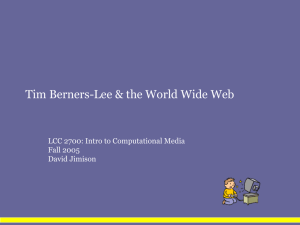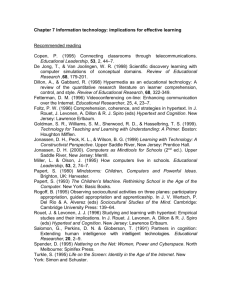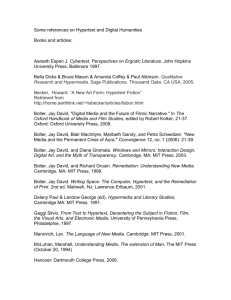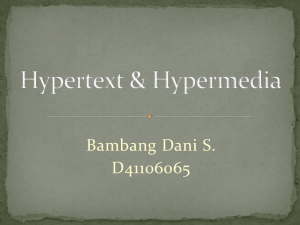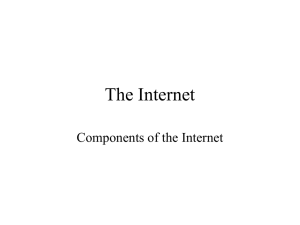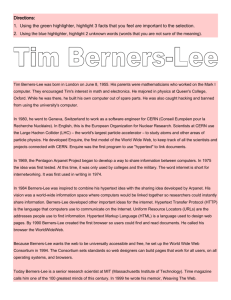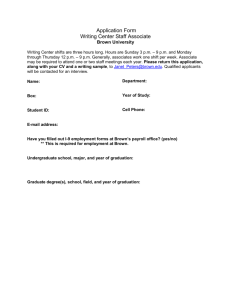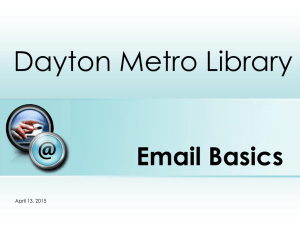Educational Hypertexts on A Portrait of the Artist as a Young Man, by
advertisement
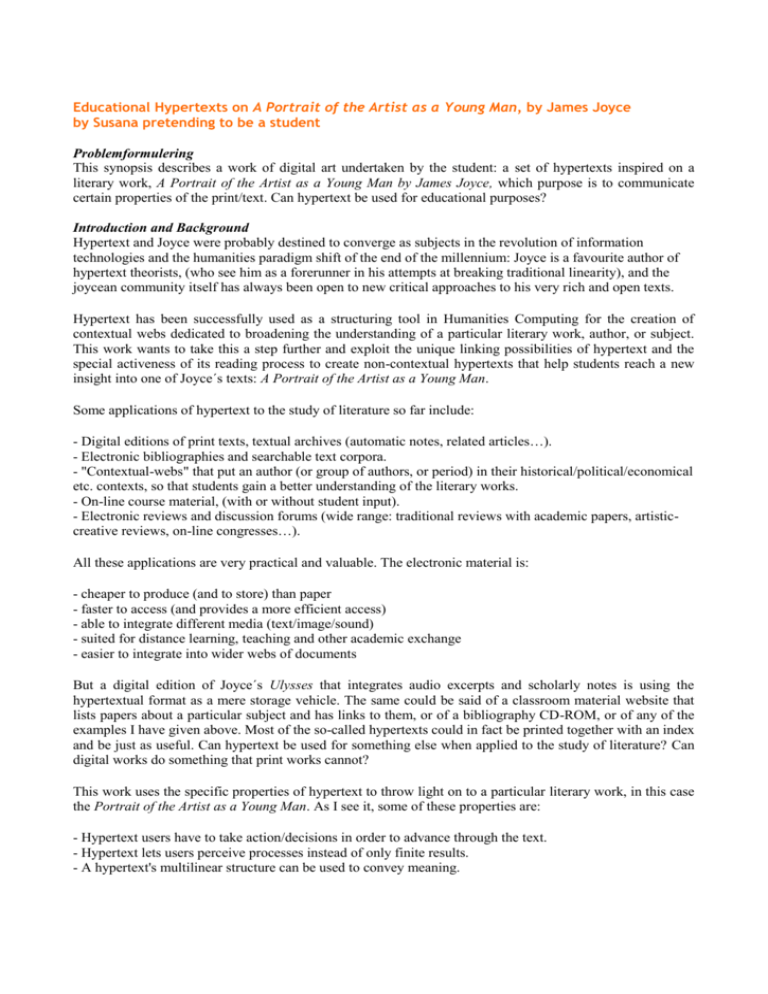
Educational Hypertexts on A Portrait of the Artist as a Young Man, by James Joyce by Susana pretending to be a student Problemformulering This synopsis describes a work of digital art undertaken by the student: a set of hypertexts inspired on a literary work, A Portrait of the Artist as a Young Man by James Joyce, which purpose is to communicate certain properties of the print/text. Can hypertext be used for educational purposes? Introduction and Background Hypertext and Joyce were probably destined to converge as subjects in the revolution of information technologies and the humanities paradigm shift of the end of the millennium: Joyce is a favourite author of hypertext theorists, (who see him as a forerunner in his attempts at breaking traditional linearity), and the joycean community itself has always been open to new critical approaches to his very rich and open texts. Hypertext has been successfully used as a structuring tool in Humanities Computing for the creation of contextual webs dedicated to broadening the understanding of a particular literary work, author, or subject. This work wants to take this a step further and exploit the unique linking possibilities of hypertext and the special activeness of its reading process to create non-contextual hypertexts that help students reach a new insight into one of Joyce´s texts: A Portrait of the Artist as a Young Man. Some applications of hypertext to the study of literature so far include: - Digital editions of print texts, textual archives (automatic notes, related articles…). - Electronic bibliographies and searchable text corpora. - "Contextual-webs" that put an author (or group of authors, or period) in their historical/political/economical etc. contexts, so that students gain a better understanding of the literary works. - On-line course material, (with or without student input). - Electronic reviews and discussion forums (wide range: traditional reviews with academic papers, artisticcreative reviews, on-line congresses…). All these applications are very practical and valuable. The electronic material is: - cheaper to produce (and to store) than paper - faster to access (and provides a more efficient access) - able to integrate different media (text/image/sound) - suited for distance learning, teaching and other academic exchange - easier to integrate into wider webs of documents But a digital edition of Joyce´s Ulysses that integrates audio excerpts and scholarly notes is using the hypertextual format as a mere storage vehicle. The same could be said of a classroom material website that lists papers about a particular subject and has links to them, or of a bibliography CD-ROM, or of any of the examples I have given above. Most of the so-called hypertexts could in fact be printed together with an index and be just as useful. Can hypertext be used for something else when applied to the study of literature? Can digital works do something that print works cannot? This work uses the specific properties of hypertext to throw light on to a particular literary work, in this case the Portrait of the Artist as a Young Man. As I see it, some of these properties are: - Hypertext users have to take action/decisions in order to advance through the text. - Hypertext lets users perceive processes instead of only finite results. - A hypertext's multilinear structure can be used to convey meaning. All four hypertexts are to be used with the text, and never as a substitute. In what follows, I describe the first of the four hypertexts, called “The Labyrinth”, as the focus for my practical work here Detailed description: The Labyrinth This is an intricate hypertext that colour-codes certain sentences (that belong to different threads) in the joycean text. It is dedicated to explore certain themes or symbols in a very dense and rich web of associations that cut through Chapter I of A Portrait of the Artist as a Young Man, and move at their own pace instead of going the linear way time imposes. As you travel through the maze, you will have to figure out why those senteces are part of the same thread and how the threads interact with one another at significant moments. Once you think you know, click on the "What is this?" link for each thread and add your voice to the net. To see what others have thought, click on "See net" for each colour. It is better if you have a go yourself before looking at other people's opinions. The text of the novel (in the 1964 Chester Anderson's edition, with original page numbers) has been divided into chunks that make sense as semi-independent units. At the bottom there is a navigation tool that lets you move through the chapter in linear order. You are encouraged to move using the navigation tool paying attention to one thread at a time or clicking on the coloured threads (a coloured sentence can link to more than one place!) while you try to find out what each colour means, as both these tactics are complementary and you might get stuck if you just use one of them. The hypertext presents four symbolic themes that the reader has to explore and find out about by herself. The threads cut through the original text and thus the hypertext is built on top of a linear structure. The reader won´t know what the topics mean until the end. The idea is that all readers contribute with some opinion as to what the threads represent before the teacher intervenes in the discussion, participation would be organized as a forum, thus supporting constructive learning. The colour coding has been made according to the following main topics (hidden to the reader! see image below). Initial tests with the hypertext suggest that the colour coding stimulates lively discussion about interpretations of the text, even though the students cannot find the exact theme. But the vagueness of the themes is done on purpose so as to allow for discussion and ambiguity. Initial testers report satisfaction with “another way of reading literature”. If you want to have a go at the hypertext please visit: http://www.itu.dk/people/tosca/tesis/home.htm ----------------------------------------------------------------------------------------------------------------SYNOPSIS WOULD END HERE. ----------------------------------------------------------------------------------------------------------------COMMENTS ABOUT CONTENT AND POSSIBLE EXAM DEVELOPMENT start here: ----------------------------------------------------------------------------------------------------------------What I have done here is to simulate a description of a digital piece (a hypertext) as if I had created it for the creative part of the course exercises. It is actually part of a real project that I made for my phd thesis. The synopsis contains a description of the work with a couple of screenshots (screenshots, drawings and other images can go as appendix to the synopses, thus not taking up space of the 2 to 4 pages if you need it). It also contains a link to a website, so that if the groups actually had time to implement their prototype the examiner and censor can also have a look at it. You don´t need to do this however, you don´t need to comment anything about users interacting with your work, I included it because I have the data, but this is not necessary. Apart from the description of the hypertext, I have included a background section that outlines why I think this can be interesting theoretically (in very rough terms), so as to anchor it to the pensum. You should also do this, which basically would be the same that you will do in the last day of class in our presentation show to the group. You can use your presentation as a rough sketch for the synopsis if your group decides to use your artwork for the exam. Remember however that exam groups cannot be made of more than 3 people, this is because in my experience it is very difficult to examine bigger groups and find out how well so many people know the pensum. If you are more in the group you can always present 2 separate synopses based on the same work, maybe highlighting different theoretical aspects according to your interest. As with the other synopses examples, this is not an academic paper and the structure is quite loose. That is ok. So what would happen in the exam, again I would be asked to refer all this to the pensum. For example: - In what way does your system support the 3 specific properties of hypertext you mention in your page 1 of the synopses? (Session 8) What kind of text would this be according to Espen Aarseth? Is it nonlinear? (Session 8) Would your hypertext suffer from some of the problems described by Jane Yellowlees Douglas or described in the lecture of session 8? (session 8) In Douglas terms: what can your hypertext that the text can´t? (session 8) To what extent is your hypertext a remediation of the original text? (Session 4) This is all very limited to session 8, so we could open up a little bit to see if I knew more of the pensum, for example asking about: - Which of the ontological properties of digital media is a play here (Sessions 2, 3 and 4)? Is there a connection between your educational purpose here and Ole Thyssens ideas about aesthetic communication? (Session 9)? How would you historically conceptualize your design of the interface for this hypertext? (Session 11) Yes, the last one is a bit peripheral, but as I said in the other cases, not entirely unrelated, we cannot stay at only one session in the exam, so these are some possibilities.

